The debate surrounding the role of the fashion show today is escalating, as more designers opt to shake up the runway format.
A rise in digital integration at fashion shows means that the audience at home and within the venue consumes and creates media instantaneously, but typically that feeling of instant gratification ends there, as consumers then wait months for the collection to become available for purchase. In a world where shopping is often just a click away, this delayed path from runway to retail can feel dated, prompting a number of brands to attempt to fix the format.
"As fashion industry continues to evolve and becomes more digitized, the old rules will have to change," said Yuli Ziv, founder/CEO of Style Coalition and author of "Fashion 2.0: Season of Change: A Forecast of Digital Trends Set to Disrupt the Fashion Industry," New York. "Collections, seasons, fashion weeks, buyers, magazine editors—everything and everyone are being challenged these days.
"Inevitably, many processes will be redefined, and powers will shift," she said. "Despite the threat to the old-school industry establishments, the restructure will be a healthy thing and will eventually lead to enhanced productivity, which in turn will leave fashion brands and retailers with more time and resources to innovate.
"One of the reasons that fashion brands don’t heavily invest in innovation is that they’re preoccupied with the chase after the next season. More designers should be creating products with long-term goals and thinking about turning them into multi-seasonal successes, instead of trying to capture the current trend of the season and move onto something else in the next collection. Only a long-term approach could create truly innovative products."
Ready-to-wear
On Feb. 5, Burberry announced it would be shaking up its runway calendar beginning in September, opting for two shows a year instead of the usual four. These presentations will now feature seasonless apparel for both men and women, all of which will be available immediately after the runway show.
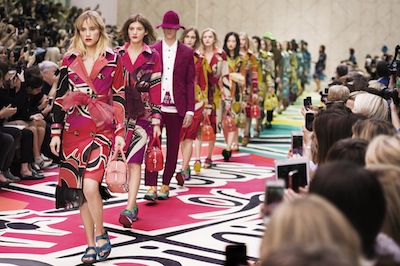
Finale for Burberry spring/summer 2015 women's wear show
Burberry will also be releasing a coordinated ad campaign right after the runway show, capitalizing on the momentum of the event (see story).
Prior to this announcement, Burberry had experimented with immediate gratification, allowing consumers to purchase select items from its runway show online (see story). Since the start of 2016, Burberry has also been designing seasonless collections, creating a mix of apparel and accessories suitable for more than just a fraction of the year.
"For those who work in fashion, we're used to working within a number of calendar systems that include market, retail, manufacturing, etc. We're constantly working on an array of seasons," said Kimmie Smith, co-founder/creative director of Accessory2, New York. "This is truly the trade/industry side of the business, but on the consumer side the calendars and deliveries don't translate.
"For those who shop there is a divide between going online or within their retail locations to purchase items that are not in season—and we're not even talking about the fact that the weather is making it impossible to stay in step with product that is coming into stores, juggling between fast fashion offerings, seeing behind-the-scenes brand content that within a few days showcases what is being made months ahead versus those that are available now," she said.
"The system is confusing and it's because of the access to digital innovations. The fashion calendar works for those that are industry side—although modifications can be tweaked here—but is completely out of touch with those that consume fashion."
In a 2015 presentation, Stylus Fashion’s Sue Evans had advocated a shift from the traditional seasons to a mix of heavy and light items, partly to account for fashion’s increasingly global audience. She explained that brands should take into account the fact that when winter hits in Europe, Australians need summer attire (see story).
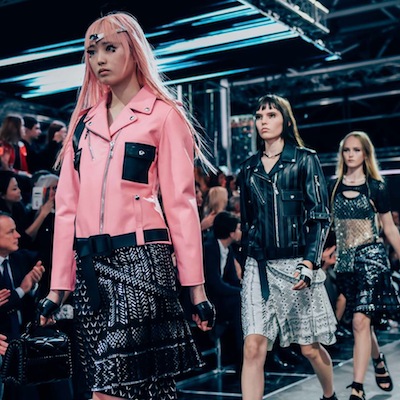
Louis Vuitton's spring runway collection included leather pieces
"The chase after spring, fall, resort and pre-fall seasons is pointless when we have chains like H&M and Target coming up with collections every week or so," Ms. Ziv said. "What’s interesting about these collections is the fact that they often cross the lines between seasons, and their pieces could be mixed and matched. Designers should be focusing on creating bestselling pieces which can stand out on their own, instead of worrying about making a cohesive seasonal collection to please fashion critics.
"There is something liberating about the idea of ignoring seasons and focusing only on great products," she said. "With the growth of ecommerce there is no need to follow seasonal rules—the online customers are coming from all over the world, from different climates and different demographics.
"Every item created has a potential to reach its target consumer at any given time. While brick-and-mortar stores have to answer to the local demand, online stores have limitless possibilities when it comes to reaching the right customer."
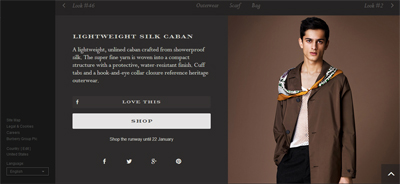
Burberry runway ecommerce feature for menswear fall/winter 2014 show
Also on Feb. 5, Tom Ford said he would be moving his scheduled Feb. 18 fall/winter 2016 show to September, placing the clothes in a more seasonally appropriate time. The show will now coincide with the arrival of the collection in-stores and online, removing any delay from runway to retail.
In a brand statement, the label’s eponymous designer explains, “In a world that has become increasingly immediate, the current way of showing a collection four months before it is available to customers is an antiquated idea and one that no longer makes sense. We have been living with a fashion calendar and system that is from another era. Our customers today want a collection that is immediately available.
“Fashion shows and the traditional fashion calendar, as we know them, no longer work in the way that they once did. We spend an enormous amount of money and energy to stage an event that creates excitement too far in advance of when the collection is available to the consumer,” he continued. “Showing the collection as it arrives in stores will remedy this, and allow the excitement that is created by a show or event to drive sales and satisfy our customers’ increasing desire to have their clothes as they are ready to wear them.”
This event was already meant to be a departure from the norm, as the brand was planning to stage an intimate preview instead of the lavish, theatrical shows of its peers (see story).
Breaking the fashion show mold is becoming a trend for Tom Ford, as the brand opted out of a runway show altogether for spring/summer 2016, opting instead for a social video of models hosting a dance party in his latest designs (see story).
Tom Ford Women's Wear SS16
For the past few years, designers have been shaking up the fashion calendar by offering merchandise right after the runway show.
Moschino regularly invites consumers to watch its livestreams and shop a capsule collection right off the runway.
Similarly, Versace let customers immediately buy items from its Anthony Vaccarello for Versus runway show in 2014, speeding up the wait time for new merchandise.
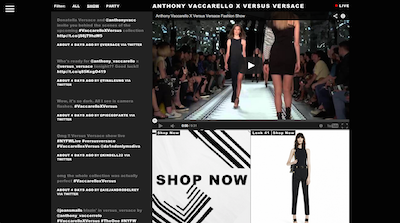
Versus Versace live-stream
Typically, the months between a fashion show and store availability give fast fashion retailers the opportunity to copy the original design before the real thing is available for purchase. Moving up the production process to before the show and making items available right away may help Versace beat fast fashion at its own game (see story).
"Immediate collections make the most sense," Ms. Smith said. "As someone who attends shows, knowing that a garment that hit the runway is available immediately after the show will not only increase excitement but sales.
"It allows for brands to focus on all the creative so that everything comes out at the same time," she said. "Fewer runway shows reduces the amount of time spent to create them as well as being able to target their customers better."
Fashion fatigue
The never-ending cycle of fashion shows is the likely culprit behind the departure of a number of designers, most notably Dior’s former creative director Raf Simons.
With upwards of four shows a year, and six or more at couture houses, designers need to pump out new collections ready for the runway every couple of months. A move away from so many shows may help an industry that has recently had trouble holding onto talent.
There is no clear answer yet as to what the ideal runway show format looks like, but the issue has been noted by the industry.
The Council of Fashion Designers of America is looking to find a solution for what many in the industry find to be a “broken system”—the fashion show.
An immediacy of content streaming from social media means that consumers are now experiencing collections right as they happen, but in most cases the same clothes that come down the runway are not available for sale until months in the future. To try to find answers about what place the runway show actually holds in today’s fashion calendar, the CFDA has contracted Boston Consultancy Group to conduct a study (see story).
"These days, runway shows are slowly turning into marketing platforms for brands," Ms. Ziv said. "They are transforming from insider-only events attended mainly by magazine editors and buyers into highly publicized events syndicated live across multiple channels.
"In addition, as brands are becoming more independent from buyers’ opinions, they can test and release products directly to consumers," she said. "Direct ecommerce becomes a powerful channel for a brand’s marketing and sales.
"Brands have to start making their own rules—whether they choose to present a full collection or just one dress, whether they do it in September or January and whether they’re competing with hundreds of their peers at fashion week events. Once brands release themselves of these limitations, the possibilities for introducing their products will be endless.
"Maybe it’s a runway show, an art installation or a concert? Perhaps it’s an ongoing event released in parts, just like a TV series, driving anticipation? Maybe it’s part crowd-sourced? The new product presentation can be anything, not just an expensive five-minute-long runway show in which people fight for the best iPhone shot from the last row."
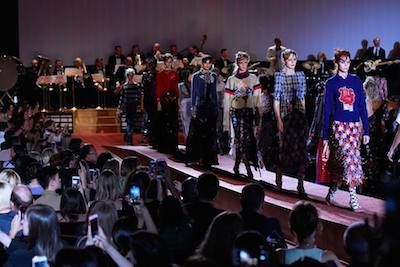
Marc Jacobs spring/summer 2016 runway show
While the runway format may shift over time, the fashion show is not likely to disappear entirely.
"The idea of presenting during fashion week is always being challenged," Ms. Smith said. "Some invite media to a behind-the-scenes photo shoot where they can come by and see the line being shot and can share socially. Others create standing presentations that allow those to come in at specified times throughout the day. But over the past few months, having larger brands challenging the model has created an open discussion to shake up how fashion week can be worked within.
"Fashion shows will always exist in some form whether they are large productions or intimate ones, but doing them in season like what Tom Ford will do in September is a page that every brand needs to consider," she said. "The same designer tweaked the runway show model by making it a video that went viral due to creating excitement to present the upcoming season, include key models with great social following and to launch Lady Gaga's new song.
"I believe that brands who continue to present runway shows within the current model are those that have larger budgets that can support the expense due to the iconic nature of the brand. But being able to deviate from the current formula will allow brands to competitively showcase their lines in the way that makes the most sense for them."
{"ct":"GTaNz\/ydAZbcBQMda6foEEbWZLCvNFrsHQs\/Qyw13mcUVXlBWizpvyyPGZ81YxnFvOMLSseWV5sv2qQ5uaIacJQO+fhVcVRdg1GmHHa2lJhWYKIJSh16nWpeDv2ZgcOGLlASbDKfLIe7YykHdCQUW3mJzTQ\/+Rj0X3skB1PtztjLvJvkkMgF6GakjzAUCd8o3tYpBVvZPG992yTXgI6KoMNecw2Tq+z4mhI68yt0FIANgSCXFBYteLpgiWoXCPAHwVwS137UlRVfkyCI3C7RX0\/iClhCunGOOUpoZbI0roE3D8zhGQlJttHmqNpiEwVElkK74WfW1n\/KjgLNWJSK0Q8+5SgUXPvoEwhKCudewNVK79fKjsxfpcJhC71r+XxUaueJqw+WK218aR4VbfwXE2bJ7B3nIAWiq0H7mlF8s8R+eXhkPlFPoRVqGi1DAYi2m\/5BWw27Gyx6wBBzVHQO8R2codo+6kdspWEsR25kd6acm62PEczEM6d7iyvg5333Se4uiebx4qgSwLkf9yWqHZL8AYsgseX6CkU55HdTKooM9fF1hJGwfTh0Ts6fk3Sd62TTDeeye+i5pbMTogNKafO\/jiHsP8lLs3Auoq5ixvT5DDuX1cBabEVgf7weJouXg7PSUYLgwBnmVlHCsyb4TAXDlUqI8vqiQU4pIWJFVNgG7YkCHNSHYKz5Xfu6YW8O82NWp5SaPM7xxXw0vzjipHNNZW1fqboCvNScxpTa350SYaS8N7aEDiqPwA+rEoZ6IM4mnqpIiND4DdZ5kG+HgzOBoQlIglNcpAZ2WpCAEaAKeBDGc4UNgvTcDmQ75XvK9jAUQY0dyFUglqP4LKLlZdUOpY6w60dxR20x8Xjre4DSwivC308mwKSOOuyd0zsyMf5tDK\/SCrojrPiEfjYXWaTROLc+4KlAkaPU1X9+Tlb5mCWrjlNyPSHyHVXaefuX0o2gHExgXtrxHXRHDYQ6M\/uVcuvQmnfirWz\/i0+B13ujPQ+KyglwmMOuV2DjD2oUzeDfRJ8n\/bOH9+mtYUpoQ1MNqzaDu7p66iF6gjsLYU3S5U3uTLLTo\/p34crgxKhR6UaATozEfuAQwzyMx5DhF71SaSwVO579oFERk\/iT4\/Zk1r6+1ISGjBfEm8UOigdXiDtoM7\/VOaIg\/VP2qD3pKA4E3gYfFSzZRMa0YDsT4YSiDP54us1nm6ppD16u4etnqyzl0kKy6IXtELTmJRywwogYsr\/O8naJdtb\/JpFIKi3hAjJb\/xosfe+o0T5EUhCeglKCx2HadmEwvQxVtG4qRUvQrYu+2PrPFjCactjync20H3epGs9QgpFFtfD2hwZYh98zWDLiIdsMtxbJsK8gsuzZQgehc556xI7fuqtxV99zV9XLnWI2HfIQ0ja+AEYU+yCpZMajw\/Qch\/vQbEJWTsS3Hcac30xhmCYfk2fIeGOESmodoZl5Om1rtzF28pRolumMNPlNr9ADYWnOThrSvIu2ZSh5xI1LO+wJllS+URKIAzSerpUpZFiDOX4c9n\/XKqEEQDf\/q+k45tkT3IZ1g9QKSuxLLZ9uMasKuYpN55jVC8xjwxlel0EDL4tar9WFUpulLjdSaS2CTcclPyzAKGGrNz58HmMIarPSivDv0OWoKXjZ4Yug+0sng\/27K60cQWTZzIGvqgihsYbQxIzHnkAvPTtCGnca4tP7Nul8dcGBmlj17Nq1v5wvv440vqu1ybtGLRZJ2ZIIloZdyWl0bVWcWpifEgt3pHjm7ELhoz60Scxpi1DPHjErAZ6pHmpPGXFq2pw3thzDufXNEu6NxbznOQYj0+\/E1DYgPmy41Wd3Mh9VhUeckluQ1TIO7lNL1rSBsE0oxB5JSPsnmIpl\/aXjMO\/+AVi7om\/l0\/C\/yfb\/uvfkrLYFfINNJjzagKC+JgSY6FH3nV+yofcMFVUeTWoOD0MWFsf3m3uMA8BE6efXVR56RMLaYEpk5LejVS0z1z+ugKF5bbZnuS2vLaszNyulDr7e4T7sGD1ZX6WD952s5Duxvnc12UHop35AWDwh7\/4EOKXjolbmGQ+9edbRW8pYtZBAMhadtGySVwqqyd6JDYuJSyKw7u7TVzaux\/RfeSVUKkHuSBZBsnk3w5lOqynTF1C5Ea25AjaIJaQszotdEFlqcGB7T0jUKU4ObMDZnjhpxHfpBzj\/vfB2m7PGUzMmQ\/aKfYvDU5G13cieajA5MNlQKqR6E+tf0A4y5ayA5e2AbeEETOtJuAuknS22UBUSxxnoRPIJS3xyHv0Tbw\/tJvm4jqrGCTf62bPitORgxNVGbLTrYkEzTcOJB8F10prqPztUd4osy7hXU6LEghHTPpjbVPSJyQjIOJosXf1ANVcnQI8CoLwkMzbw1tn1UfmcxdbV6MgEfcO2p8oiNmzhGPoSEjXe13NIq9sNwfIlQBvDN3F+Wj3BSi1nBJzVtucPOIYZTq2QaNQwXW7ApMSMNaAp6ghP4EB68i2KnDjy9m4kmRGGHUN\/WxSyIXjgAbM+m9o6bcGDW1m+R6GI0iuGcHfGnxQPPSVuQtHnVRudc3AmWRTeHBcjQHrfVqDKc1tRpPOPANzbBIPK8HoeNbQa9eCL6SrU69EreqMJuHK2rpeMN7KJBXB018WjeoJcmk93E0I3bcPXvIv9t1teaCL+yZImFbSAfsOM+jesRoPHCyVcGsvUZFr0Rl8QzWYfhtVtLneWmqmVMdq5mvkViDnagFspphNE\/fBcEaQGcHtcAPMgMKLBio7YP4BpMVSKMC5NFBY8FM5u4w0XTJJJJHW52Iq0DLwMjFKCBgWxmRDwYcW6QcqDhAY+rXTIT0X+5L2Uw0xXi33jOIlVE00ZdUbxQWLzBBKe1QroJKZjzI5bbkxZEgT6cVZeCHJ5VhF5Gb8d8GPe\/Y\/P3jpQTarlFwMOp\/HtFHxU7Osh2LROsB9wuhTmwCqgVCUoulBPO+BwQxMcPg5gLJFHP\/uknVbQky1sw\/d\/vf55dPfajyjO8cpmaO7OY9oFNTIitGU\/d5jX5C1dzBqNBzHB8VbK7WWmnYJyrQJvYvc8GQrYhVrZpUEmq0pO2cPFeqOquTJEMCqChUldsqOjDx89A1s0afPd6S026UrvQbFh1MeyHDX+H8M\/u2v+okWCbQh8tqprAHC3VKIJFL+BSzEu7oA5SxrZRUqFs8HhNAz2L2e8Azx6jbtd2FWn2KLJgakZCeWpF7iWdiPmDHaTd2rH7E4WfuVdkvbcaAJBd1g43e7UGebcIe\/zP4w6vPSSdfpDOBCYp9Q0KEKv8JkmmRAKPkyrl0I4hs2jUav6aPY6tfbJhaEAn2SmqvnvBvyVcpqZLfrImXqAthNDD+v6NWPfhe+sFYjOQ2bX00eG1Wfc\/b84PFM+Sy50OJtVevoQBUBFnFhhyde5AIP5bTxAzXcUlcn6NE0MdGALWNJQCdt1nhxMg8rOoExOfttgBwA+sXDj628xE\/zF6l9ja581eE3+7r9tJofHAWXnHn7EQNUtHYyLnAUD3Iu8J4sDnC+CZhwtchMyDwTTWN8CWmyuwauzRpp2fxJG8Hp2PrJGLtqDqrHWeTAfTyDPAXHjayvCJHkZDBE4ekhcc5agompPAzDqm+xgXiu28EfO8omvB+QJstBLN14i4mr9qIyn+VqkuHG2RhAbjXGnEbsdsZeqPG0r4Tck7E4zjyHUck\/Xfy\/f2dZWjfayl3wISChahCSnT9oyEiGdJG2UcITLsjhkDN70x88CcXd9F7k4kcN0LR6mAal3qHZ0BoqFoV7GtZ5OM8XbeJXA\/jgVxnntHhk4VZFDsHRkRMQFaQnkDju1j7\/P7fXwWAyj21tH0IgCP0iE5+1JOX53oITeV5ekbLmf5Y4fdvXqwcLRFil0jrva9CVGww1o+Ok79w7QgMTGYr3XRzEoi4QUkj1PgnoxeklSvjPbChSkNmwHKo0Sh3wdIXkEkglX4pfmTH5vpqfZCQcRBarqtV+sJOZA3tNbeLTm9LR3jvIYW7p0j6JhsUeqihBfjFTi8qsoPZfvzwO\/GuE2BdRhYxduIgq9v9mHjsdLDGMvDLtb1zUKvlnbcROwBEmUv3dDrwWH4m7sQPiZ065CRulrXyih7G9iY2Wf8ooKst5k8RZvhCGKZ2gjSyT+8J5c8K8h9+uzGOp5n0G5T1g0lVurxyCWURlD\/5Ti5MJSN\/bmGgIAiVTxwloGENitmEuYoVmZ9i7TY8MZKcVTzYXxi\/F9XPcu2Ve9DuF4AobXfDl21VcLWKxt6uiwD\/Bc+KsKSEt0T040+dzYOGSxWvHL3yb\/TB4jME8DmqQb3NihMaZaq9wpii41Y8sjuYTiFJG\/hQ7IabqFT+tSsZvhLeh5r16LwZz+ov3ImPJJdc+RI7p1zMaUcAK1uACGjMNxGSXGpwKO5soS5QdbU8o0zPybBhjTGw+pmONWGjhCEemw85aai7rvKOMDIk8LBZbb8zpKejgTzprQ1hRp0YZZkXYj1eK3RXBUF4wk+7l+XLnvbuauXQahTY8RjllaJyrc\/12uZ47+vtD7ZcJSoQx10ZMbyCaND2UWo+sEZ4Yz0VB\/tMw97YAHsySqHfMVVJgIJC4HhSuaLDnoMBwX25owZ\/AaObJRoA6oXmTsVmDmNmSeLvVkWygjgHaE9p3QvGzi4luIFyCRiyZq70vz\/qCOYfb2bYp5m62\/IDC9uGMLP8Aux5taVLw4G+wZ\/FR6iqVEaYGIWKXEhDN5VTDdvVz5RTMW8gFYOS38sX1XB2qJijTLiv+rov8t+WfklQUzlohHrvMvIfpVJ+FQJ5E7Zgk6YLcIT+FDtRiMwRjoIcb3zVNC1\/Hc0dIFXoLN1a25JSvfxMU2LQ2t0fOekkIoQ\/cEdKBbDle0SX8QibaXeJ+oQ9cRbaW1na1nr5fSzuIFO8i40k3GbpFPTbHiYj26fw3pJBUYlggt1E2Xp0DO9CwFHn9xEXRvbPBykRaIn4ovjuulYcZn\/oVCfRxP\/yegWsmAuru9qNLB5xTjfPZvuE3ifasEduRqpBdyS9Nd4TDJ1RBUgk7v+FX7qTplx8gHLEDYi01y+2viaMtYzvDUJ2ApM+9IPt1ziW4AeTljyw+HPnenI0xnFnM5d5joiWhwkjg8BGxeFtxCzOLyqiStOjMLZJZ7PIV7tc2WMvzrPOpYqS4HNH7Womz\/c3hhBt65Xr7V1lv3RGungS4En3WwsMEUJhqHGioca8x6R89GdSFnalDP5YkaBDVhSgxfvHWd2finpnnnNr64c4JSf27KJmgy6ARDrZ+isaxM44fJ0yjINH1WAOuDKfnmas\/qJQxhn0bWRz6emTFD7vnFWJLpzLZM2ozG17zzUDsCTK6FJocYltNDM0vr3rpS1Ppsofqka2I+Su7wWXVwanx2T6X\/8oHf6p5bh2lSf0MDM0W7gkSGMFtq9UDFpqAHvXu7s\/fTnT\/cmwnGLMzNlcPw1Xfmpy1941ewUiLP0toro0X6arpbzAg3B64F08TDDE+FYytOf4wcIQ+dKxIFAOODHX\/cKKnkD6UT8\/mYtQ3cRiidBX5mP9aYr\/7vQC\/q8kOzu0vs7aIxYpEbpr9INZQRcOlgN9WAhDXF0pTeOmiKIEHjsz1LwjkYbxDc0AZllRFSXtqjKw+LVVR0jvEbo5e0ckDS0qx0Mlzy2hrCPAtC\/nWACkBOBpQgKwxhmDsE47c7i8hf+VkKJxwdLnjbwy21J6d7NGKJUouneGl66MkhDNaN\/8fRFVi3V5buaxFlZqyVynQXuq\/Ee0czAq9ttboT86BtU3GagZMOg\/SOzNJk1IerUJCmhi\/AkljE+F9uZy4UMZf2n8QNYxkjQ76O+ORNLSbBJCau57\/+hlCdX4I7XqlhXXeQulSh8BoPwawfBs5X6zGKFv\/\/kQUMtQV1vWfEikSLEcdz2zdy\/PrhRLdNolTI4Jiwih+sYy2Fx8y0YgTkGTn5efMaflalA+\/F+OAgDbLUoxatQUJ4lUtSPyw9TI16Wj84BfZxjJsQliUhKN8Syc8XjF+6okc6Ey3RQ29Rhryz5SrTOYC\/5a8IL+6j+I7nSENfz9OZFWI9uFnKeDNCqO5wFqDNKasgyL7CXtwMNtlXCzDKnROkqiTMj8k49pV5Ghf9uWBpOKa3V157cx1AHCT+foTfDjb3XuxokJp2++PXNtgMTl+JaTHuCuauFKygBmVjebCxTKILeSI5QXf5Z4DOzKGp16rHLpeNpYvaK393xZ98nmIcKA5wTynn5eaUeQ\/HkL+pZt\/mgCl9Ma8\/A\/TnXbfKn0AtDGu2Z5fw\/g8bp0C+PBqdYN3d8+iyO\/qKZ9buaeTXd5\/XxeAHBNJfrzxQucE+Dw9OTueoKZRoW7qL7JMGv\/gjy7OcEQk\/0lyq6WvfkyOPReIK7YOQadR1cQnQjEMukjz\/9G4IAk3256gpw8V53JS1KMIM+M5SrbatZVgxRmQRgguLUDjDKGeHkS5FhaQ0nPxnV4rzFlL+sBFNRs4XVP2l2pw4KbSutCxl1SHojd1TaURmNo2wYHHmj1VXz7llrVcPYbC9zI7jbv1Vd6U20m7KDcd5LQinDW9uzvAI8T2LCORO5ny6XtCms7mbHwul2M1voUYadJ5PzWmPHBYZ0IsC7dIBWA751DwdESFm9g62c8SvAjVoT921TOPJLNqokPDB63cyffCk\/EKQGzTcYdnfOlO15lEE3bd9e7vOqzfIj9rnBg02XaIkFduJ\/\/19S4cX+MmkPwJiBNJc+TANcnmo9rUD1DbuSzSQfPehBwoLRIciZmLxzZF+E2m8\/l5I8iYM5qWHvTdYfeIbV6B9i++sFTGMewyCD5cdlSpUvIuZr0ROZP2cn7\/d9pAhE3Im+c8yA2ODakrVFFvC464dY7PfIXKgs1SapbvJvygDM3K\/qFHThxrfTp2AxkDc2WM\/VEEhhVoKgRNRjTypU\/\/EdaLMEG++ehwH+n4XLfQ+6OaIEioBJD92N24Q2oUop8sY07UdkX2TZRXzm2kPsAgMsrNYtOgg84je4y5bK0le2Z5MrbGp9qBZxcF6WZs09JDJiqE+RU1\/wMTtpGU24rwLWdIiwKnY5chdu9zqrKuOZSVoZpyD\/C7yqKMI\/hNoJaCvvsS0\/eS8vNwZH1VfwGN7+qT+E7l5ppJQJBhikTxQ8MbB+NBwYQJ+EKbacVUbixDNGOWxLm97o5Ei\/i6RGp4st\/avmbQCTfDHlFt5Im9uG3uNnfPCTGeUL7wQAHMB\/942lGOCAL7H19XT2YxHvEy2C5vzntjhAJB8q+pM1JQTjyrvD2hOJFBozLJLIev9BMmGE56wv0DvBP\/7JCIcO8CXh0JIys8N7XGhcLQ40\/1P3eABbObKaVY9ktsuCJgt8XOsgkeGRYSCxpUIL0CXwSXVbFonsoYUBli8C+pvIt4ipUHrVcQy11Vszq7vEqJhYrKJbTZPb\/ckGp6\/OwsldhSYzLbkcT3lbwV7wn0V5fLmg2oLd5GEOhKoSAZBAXHjVqvsXtc8aQkLKIwYDawtI4rpjOT7zb6AwpZZMlKvXjLe\/51i4E1rAv7nPVOK0EBym7jqe0tcazz72W+pm\/2all6JtrbsIsG\/S0p8\/ERU3H4jAXhqDEXQs7ANZ9HiI4V+9PP+93qkHHAcDHlSVuVJhtuET81dadYKhjJPovfQPkf6rSJfvJXA3BleAt54Rs29ETBDWt2PJl+aQChbSbbcsHxHgrxCDL1FvFcfi7P1AioepKUlPE0AdW5Wq4zsSvdOqAjETT+R7t3N64\/\/cJchvEF6bJcg2i+qQPcwXVyE3gd6fyYmRfc\/ttZnP8DadBYFLbbEc72tEyzDsxqBJwd6+MhndrP1dcXKs5n3rc1mjkbnwIhpINPzqrqskGFq3\/vP8WatP83eqTh41+eozCll2dY4qljqetIqsazcaZc7vRYBKs1foDy\/HRke9SkQtFjGGao0QaJDJJQNG82OWw+kQVGPMPUt8o6XRYBeBThBz0q7dJLwaBjpHPyePDPh7sVUxDLp61Pdfil66cco4nPaXIEdFV4j1VHpaUnBtby6cTRq6K76C14NPxool8sBbTLyP44jHE14HH2g1MeMdqVPSbndFhc2NaVP7VKBpYUnvHGHuxNP4TNfTBsgzeV\/ZKMMfNz4WJkNEoem9nyddK39DuQW1sKMI5d3q6BB2f3ua7r\/oGly7XSZL9gbY1\/316SookbzFj2T8BFeelSUN8ezRY44YqSf\/dhu3L1iegceqMdITq1KKC8rgVzG28gGQLhz9Arf7x5at3+L9WibhjQt5K\/NGPrvIOvtzF39lSh3gaKDLLDkjQU9seMXiR9H7U\/la0nzDsT27i9HzNvaA2IKWEa6DlCjHJ0gq0AYsaQ7Dl4H3Rieyxl\/r\/lsPzS2xYI+EMUgeJgrWFS8ZQC6fz3h5PkXEZ7cnA6nI0hnZTF+IdqYPgrnfQ8zcemIbWV\/FXXrmH+XQdhpOcAp3sQoDTV0C9xJ16BPhaMYbONdEiQJuyKgZ7aj2pkUa70svDpUwZRKB87B8GhpDYTOvGDSlTrNIEcr8LhCg6I\/iHGcEpKXmhpPxkhQHPmq5WnDNbw1yPbKe\/CgJUVhk3QV2X9aqaqOSvTlDTZBhH2jIrBJ+BW1UaYaffs6XN096jxI9NDbjhZkzGqZgtvqduUrqUtoY8KDcdrQHUatbmZxQfWp6X0X27ka3irpiaLI2MarwZbfeOzU1hrqfKmN42p6H86PRZ58ZMHCD\/kO55f3XouXI9GlOuUZdzhBYZCVulULqB\/fNt0fLJkdZHwtlcBy6klnu221mYC0I5PWZ3cNW4l+P4SI37kLAS7QexVGMRW1JU2zpRRGEZbEzDRQFU319mCObq9HGvW+d13aUhB3qqwQhRVbxvlOT\/mEJLJyqtDjLcKqhrcu4ehTpVFY\/oxUA4nZj3fol9ybHJtW9RYGfP2pBg1oE3qvJtxfLFRLVg2PL09wqsWXNFDaJ4M06nv9a8TNT2R3JMaqHjvOh80B6zVPG4Ytj700UDtPIGcSoJ3i7c4Y\/p5o2uA\/AtncHXqv8eRtLrQ4DGCoYJNnNNrhlIVzFt3AQTkCMzQsYB6K9hdXitvFqyuYact0Pi\/lgJQ6Dansg0niUSi3H7SBMqYL98wUobfBC96EKUszq5pRkeckXgQ3m6bSSFJg+8xDeNMkHV97a7UuhBVJPpUv8nseiGeSwTgQOmxjmx4peVhSi1qEFQ6Avpc3HPgHFWcRoaGmB6P+3ZLKuq66MMDKf1xOq+sblV73NzsMOfW2UV15kbg+iiwdDAxlkJBHetQomZtqDvc+9fY80V5PzwDIuVnQonhVMKn4kSPkzPj44ZfKQcWKsSh32+tcNTxkHKQkBaGm6PQw+tyPI8m29kmqoRjnJRxydlcD2D+YMn2RvPEHEyChgymgjCar3piCeaT+BvXiPYzRMLyZ7H4pKUCPoQP\/J5RerSaHhtwp+KLT3EhwslCl5VeTYrjiMyfSAnkyVcWVAceLmcdwxPkTBJkvUmEz0xkYoo6QFko14ZkENRcnZhhvTDbbg2smvJxvGyn+aqhXYC+nNHaun9kyC\/jexbvUnVrtexYBRLLxAmBv9hByoAwz\/Rimfo2F+5elkzE8SlbvYALGntbpyugj1iZyIctWqBBYW7lrDL7+XpErb2t6YeAL4M6CijtMjTPoWPAmkyMwgsMOC6OZy9vuARCaDNQAydiwiCEDMv7YGF1WzRRly8xA3QxIcWqO7W4bSIhSE+m1Ef+3t6z1ep7tN80aOMMoa2YQ0Bcr7G0c7QyUecJ+XrXYPuOybuZl\/7oaXuNvdOLcYx6uFb2KnBhPuZNGZEg6ZXqyZunpkd0GWKKJlqgvsBDS4Z\/1HZe6WOtx\/ly5eUgXm5vCbR1\/NfyVKkwbfUiyaK3eMb0d9fEcFE\/r9ojmNHbVXm4qJb6h+8y0wc5UMm71wPC8dTWZ+MWMsFJUmldhaD6FAXOeEBxeQWTYL3o5bL2BAVAWt9ChEHSSXiXEtVIJOluu\/vxzQQjafmmSARmU6yPq53xn7DMka9PlCk43EipTTKxIB1JcVAiBgXHcQGjmQ1+YtUClEZ+DN\/lI9op6qjgv8dLjCJa\/TpTEmKCWJ33t4m\/SCsotRDdvgqsgYky2X+6ynrUMwjGxUD3X92318kmF5urTxqj7SP5xGLUodVqOwwSVM8bZ8\/svFaLkdvnyhrC92vwpQjiGtnc0cMUvlZGP0TEwVe4XjiQLOi13a094RmSh9BVeJPnd4cAs3iD0laJsQ8X22kDtGNuVC6TrgAHZVTkX8XXVQPzDIcypVbHfa8luA4Ga+VjecQROFUcR2HjhT79Ph0GMeYabYwgKiVY6SzWRdXH1qwkG7wqaLi8FspX2UvBmbT9KqMX9FjlKbemSm2wtJp6+wt\/RqjkRhB6E4pPDYBXiJEe7ZFXn1JxAhfm78TL7EA7b\/A2RkzJG9zZb66MwDtGgFqhbSZZ61XyhEzNCiCO4j+0gWnlbAQuO0uxv8NC6sgb\/oSq\/4YkA2j8HCAjh+lp92fb+YPc8iyRFWqoij2Y4ISkOUmtVhVNtZM1SvfDEJZgyLUTPnlS5RS0LORdCYNxFEYsOyf1ySg4jDBXeWOYbfynhep6fN\/4WtHk3sb2iszcFUgftH\/FHx5Yq0dGdpoDfSs83o1B7ziRVEmy\/EHMYHdMMvEi6TykbBw20ezN+dhu1D0Qk76GYcTERM1eTpd1g1Fr+i1DoNCsD9vovPcigIA6lpdZRNz\/0KXrjRzvArS0aog9O29bWOWXl0pRcfxEG19alZ+rdfkQHXeOiSPvCkHfdT\/ORU7i414zjpjyK3cKdet+eHgDkmpI7nyiv7XZpghXPzc2BdrxUkEvKJLVQmd4N25Pc4JHBsQUGN6vvep9xH+0Qn5GRPF4stnuaOysATYClf5u1JnQG2OVA3LfI44uiaifFEO3O3ie9EcvdhyQQFjSx7p37ArLy0gMv5czn+IywgtDZsFdeZqftf7EwB6kxxAEU7LnjcuiQ4bb3XuCM9Ro94E2RIcGBjhNKC\/wWb7ZsAQYwqTygCyfESSCjTHDASkigG2upFS+LoDf4vWeBihSVNusLR7zBpjejXaJvv\/G+TjTYnVrnsKzmf3pjtBX\/Vv2PY67c8K\/EwCO6JBh8vMkp\/Llqq7ZgfW1j6TLZBWU4yKbu+s9kQ8LMfHl09WSkxPbFSLAhiXRCrfEVLLdU0sozd7HRp5VosDlYLcfq+zN1haICuwUssurPcdOLqaF1AWu92f7zlrsvrTCWhZCWnCVbJsvo8DYhQMoA+Orv4Pk0YnSsgLqSTbKyjZNEAY6N4sLTEsXHgZVf1ZhjHO9z5sBNA43tMDf0BVr3hhPCad9Q8v4pdB\/fi75PnAywaoFq3mkue3bSoOjm7LoOpY8LSXmV4klk7LT6HiVU5YG3WEg290d5QX8kjCWmDWx9GeNsWhAzUC2XbVUlYF2QKHifXXlO5foDP3vRVv50mBOUsvasHn6nh\/itY9Kxt4ojDukb8\/i7ux6ZAmt\/RJPNAndlK\/ABlIw0QFLhEL9\/z4nsBvXG3xH+qi3b\/aDcsf38pKMhBuoOwiJcyRMqXf8dcnv7DDVU6w1SRT+657e34SmJiev2tsOxnVPkcTb+bwcgu7ZYglSga19MWMjqeAYtOGQ\/nk0Fjh\/6ZylQI5Br\/v0e9QEkbMOIe6IBP+BL3K8G4K5Iub9r2591GO7qGPb+MSqnVon66SmQ7nCEeBYdB2cKuZNwbgk\/Ziai7cs6p2vVtooBYFzBRdrC1Gkz01uSNcXFDf9\/IUqBb5weVN2b+Na4gIPRWfpeb67tFuxHs8ZWGLBsrDld6RCWvjkZjTKfoFeEJvE4A619Efw0eKlrKbpUw68g\/JJ1C59wrHtNjrH\/g4iARv4MX5Qs9iLnSvyApoQoadk84OwYVt8uoQ4OaLo3GK0lHgTPpIAS7gBN65nNYDWjJ5A4Q+PVWMSuLgYCgt14Qg\/4BJBeyXCTTaewMgYyIm+CVzH1oT2ReAvP6K+ae3ng7SHnvPJzNaBNItL1Qzat4Fy1lLjy68CNt53m2i59K7K8M6zz26TNJbptMzDKYROndPlrZ4qXjI8Y0\/hGMf9zQwwUptsgvbfkkIYd\/hyEkkIEDGwUSANO9SKUpgirINgsoWT5VshxoDns\/xbLTOQx9DlKYN0mJzBAzBZYsw7zhehcwxp8ezPi\/nyI6\/eoKbst+6N+Ly7M6SmrHjq4w2KXdJnHUIdPYKoe8TQpQjWJuGXBcfQLVy87q2oS+96Wec95QpIuriWjv9MbrKfCj6mAstV9N+HWPs1QKvvydXNkG13OQMNteVJZbOIRyHkvQdMEV+sAwxo1JtftGGMA9dsl+5jKnnGLBYZwt19UgI021PYuM5\/ZI3Itjp5ezU490s\/MDT7xVkiirN5a1KQTE0\/EBEnHSrDbyw9l4tFgILHwK4HFUDroa7kOVduEh8wTjGSRcbWF6FdB+T0BNkgq7DYW2dgX6IU7ZxkLZ4s68NSG\/9Zf0KPQ4bwXcs6xif6mZofiUxOYqHIGrOOxcxCl8d3P9rtgZJF0zNFOVZtKJcHfGvTG\/kXOImQZohyUv86sczDlQ+ut0rdliS3bWVAbbWVeKdb\/igOZjPZXIcfgK+9xblHAmGPwcJtFH+SdcR9eNQ7\/H53sbzHjZAqXbmKeiIhOKmh75ULjMB04in19JTiaH8G\/SxdXtFTFtbJCICcIqn+5UCagi8LGzH4TvNBS6Cohu7mCq9kMUI6kpQy12VAnaL9N+yb1m3PhR8jq3DU6XM2Lzz6msal\/aTgvgtGmHUDEF3jFe0ig+407BM3HZvbLBfU9Vq7WY3rFlF2gbYUEKZ163DDjURdv0meMQ13MHDU07U3vv78RR2wg7qYsRTf9d5A8LWcakKwfuWLCzZuOzAMDPhylKYC2hdJ8lO7RMRiix+noFA69P6bfaPZq84MjPZJBQL74ogsAxcqg02ojnzHnWPOY9jaFsy4p7E3Q2vy3oNslTaR+YNO+I7pXhzPaxDGVn2HGAhS9PvYsls48UE9cm2rAA9WDqIViQnT2XFTdbvIIYyRDTrCeahemE69Clkjm5PS80l3s6+6WpoaI4VjVGl0+X\/KlN489j+3z88CYHhVE\/u+VbRGvk4P224bZdf1DXOKv3KWeqFnvnsDhlP71ftJOFS7DLtnmV+gQxfssdUsKxHs0usPuwhjJf9N86nDAM5oDVgjPl14WvIsS1UeMRJQhY9CCle+QSr3ptPU1pu4QVOQhb+d7nVWXiqns11phRQHTheoSuaW1vMHnBhZVTCqZW729Odddn3mrIzWpXh1mPo5r\/Ox66BRMZrOpdr1Crt9c5OxQrx0C7Dz6xgsemm8tyM4s7QxCeHmSzdaPU9kIfnVaPncP5v6Ko\/693kI5dXURq2gAi6Pliwaf2fEzvOi0HuM5ZCIFZ0RG0jkgItFhJA36xQBOF9NNqI\/wha4mZ1lkSYbO49wt1SlRVib\/AmYiYN56m+0G\/05Js8IwVeNnbjsJ3Yq3mctP6aUM\/7v9VGD99dktaiZXDOY35LxmzmsIRzoY6RiXw3cSyBTTJkAlmuDZWsdfVIS\/nR77d\/2zJDldikmi6DBPOGYV+z3QlfcRKOJIrd6eSqlkJWzNIc0AJZbrUG28V1adYpJKltMB6skZYH3NqF+c6Zw7mZVIBjtlSqV3J\/zThsHkoDEL122UdAsO94WZ5MTJ12B1\/NhjhKlnMScJParlx14HwFQJic6yIwPiXVr2RjFtO2XojgBnXlvDUnDeGGHeFDLMlSCQicIJMCMgn6\/G4dUXFp3wz8NH4vOr8zcTB\/xnqLJJcVtMWDmlnf22QlnZUy2zJXWpZXtDFh80qn5LbMGCiz0cNqtAX8kctYVbdxGdQ590NWKFFcc0lcRSYB70VgczL0GfD93NfZFheqIEU7ecOEshqmLIWMAc5UXf2FT4wuuCXClaM6Y0tIHJ93X64ZrpZLmObvAjxli093p0qAO7mYTfTArBCay8rumgJAY9YKArAB2Z5mVhzbldDpaP89Ko6FZLxiLxW\/oyx4hRd1isqC3ivp0qi2kbyBnx19mcAn5+2YGQkmJt5k6\/6hWB9TpO5Ov4ec4Z623DRmwZ9ekNEYb6aAFUX79LE7WPXDVRh8\/dfkHGETB1VHk1YXmfLXdKisZfCUfxOYwtjG5TJdNsFL7YwTNOO3VuBjuQKKIa4NUFriOMHzSaKnpW\/mF0DXk24XSVpejsWgSZidm9IUsNBQ1FywWHfMZe7yt+d\/IEi5dWwcE9UP8dWeGcQeOqgL36lmktN\/3c0v8STf8tR5d54PEsStempEAxq0bFznqvLVP\/9lwHAJ3apc6bB2wOZ1SBTkqfNlH0q0GABp\/suK29y2tnglBpAbU2auAGtaWmDeN0O9iHMGoNETHdog+BQ+d7QT3fKbIbKNfNNx97N6A0mBKLuBO9gM0zyuYYYN\/a8AMEG0KcXKDYtyyF+wwBphjg9kMoDu8ZUccvu56s24beCNR4EB0iCjiBfgVTTiZdeoy4F1eJCToM2WL3rdkSRcdoki5cqxW57sJC+RAQQcHBnHgYyGqDTEWKvRpDzZGCtYQCW8DHAEI\/V7TGuwSWEodP+qVs6FvDcuDsR0yKVnAYwJRIpo6cxuLMj1XhDJI9kdCmxVBTn4\/LL9o6KMBYiz6If6H7rqNW7e\/JTU46Sm\/Z6sRpGy+rCxG3EbbMZQsSYa5YJXhdz08AX9f66bq1jKk2fAuiI+wPytQUr2BMrWuYtw5ze\/hDC65O8p8WkjxORRipqpe1DgjIlsbQwL65duiAcPyM72mTp2b3KCksgZ+cT+6c0rXtRSPBMxUNXSd24H\/Lzf\/3fX3CPZJygO6QEiFt6stwFiLr5PD6ukrvEBAt559kO3NhXE3ifLTz+ELhl2pcTh4agDkZRkOxieHJ6Z3Rozk5jG66yZXPGOeFo\/Clz3XWeOe3Hkf6BhbMm6zV0G86Ab7qq4PrBFcMaAI30lgvOiE9iMpUFL2xw05WcQ1QGwuALaMVnZTBPa+C62qCm+689JmH9XWTzBNKT05Zj79ABzwufPnFRqCt1+FCihcT78qR4fIHL1naRMEjviSqLEJPFa7gZB00NvTyWaBw7dRS9wjoGOVMifwmLzEu15ywQiEH0hT4Pu6CLht9yli9W72vCc91gZKuoFyESGgOAFtAxPGkP9lptGqyZ15qSt3Y5\/AzKGarKEhJ4x1y4MNTMgX2q8dfaQfl244J3B25p0Eak92rRAcBdw2KbzFYi2lMnQA340XyPf9SRFzduID43loMJS+uBZlW0rSqEvRmWvAjFRq4MRihZBK7JrwXd+VCvaOZ4GVSyS85Tb0l1yuP2O7D5HyWTEx2\/4gXUjsLaH6MY3s42TU1+ZEq+C2VBXFcTh2OjZ1cpw8Gc1xx6aOLeYY9ND4OYlXgYnTSqqlcwrzjMCi3WtUK+7F3QbZALW+zjcTV\/CyFVRWOrpi0jRwSZrTgRCUauTjk2msfW1ZNp7gOs2gPkpE8f0N09xff9Y9aAH3TEPW9ONCGSiwaK1\/Z7s9Ietk0VlQwbNXH9TpPSwhPi7QVwYVKIcWG6TBeWWJC6M592BIEUZXoAekrHgUvvpHwMJTBT456X2xLi5CEyihsp7fxUhxn64uyMLTXU\/UsmkmwxEPETuX\/johBdM2Lun2Dt3pwME6jIabJqFw8jV5WFuxr1YMppodYxXorPhAkC10Xe6ovMVc5KoPO\/y3WjRtCJcoAS++bfT2uaYAhPbB\/c7Oi6PK236fwt5o6J6Q15qLZC9HM0+c5cFkkVJ8xwVBdzpZCO3aGKz2hQGsi+0M6AQNcqjPr\/x\/rfmKhKfURHv3XTk+8\/PzP\/e7hXw9i37Fi6+z2ouPY6CJpzaADDyK8hrfAxhoOGE8UbpPmWBO5dNAxYdZ87z0MWta3usru7t3cgfFleowEEKt\/x2\/dEux5vLI+hr6DkMCI8gpeO7C4pOxzhAq1zMcR2C9bXGcA\/fYT0c\/3fZ9PJqAM4twINk60dB4UIWVR4OLRcLuCb5VpdZgedrCDWCcHfXlv\/\/T92TxdhR8CgMvEa0s0uPPjhyhRI4lAx5QV83ZLnmI4Y+nSK1MFXGeWg9DeNelFB\/nqFDxKsNNVGsHp956yP2JLK\/83mEgwjwN8WAUBx2\/vbzUvE9I\/7XZOHPSYl8KeLqvrs9+yt7odbGwtKa7xl8vLSEsrG5y\/SNlxlZzMO+rOoy14335dfI9wq8TKmxG3p6nY\/B5F0y8cgOOYnonPQ3X7af+4Kqi0KK9NPy02\/wFeGuDnUZByATqSIiUHGLVajWfeDzJSPzsr707Gp7J7fMKSxK3cis\/guNaJwM\/Y1Zg1bMa5TROzD0nV8lXLUaGMP+bcFQJ1kVIenfo7Z49rCQbxhhI1X6AGtvTHSAy0SeGsj0gRQRZwVUBj6pSXI39I4+nS8PffxIFWJm4oHq+W8bcPA+whuLper6o1r9O3l29mgEesgq+0KAUuknsIuaqygXyjlDfY0AsGT29YzZToxf29J3rXN7HEDuUwaqehpHGWRCZ\/aSXF3aDXbD+Wj6vU54XrjprUazQUIzx8b8YzWkRGPlivqA1gU\/zyihr\/VVe+LyI61\/KPLHVHVgXwkTdekTrpg+9+DJ3WIIgnPQa\/2N8B+Sy+oOiiL3rndfIDZkKJQv2UHmNLX4ZQD4beHlMrrpY6kJE4fGBYGvsd1HJW1IjG3CaXWTwfzKcRHUo6x1t9vjWw1DKU8M6dAmKYp0O0cH48Xb8SoYQrFaduGLYSAVEWU7ahXoYQ467XJ1cK6iOdiqVmA1Iv0NlE+sS1OdqLMzIwAGjGYY9RF5fKdW9rv+P9RPlkDZIyr8BX\/E8NLNrZMM445piG9OfYwAuTGkJoMY3yC4G5xWwNSLutYrg+c8JOgKM\/\/mFFPD\/mXCOleg3vSJ4qhMct21vGh1mnksVM\/sZq0nJAfDY40mpomEEOQsVbU52yV+azCcGvUWw4vh53Zpy2HEDz6RcZQwfgcSQLHIlUpu6xSv48znUoqSxb8zFfgWvk8CnBAFWR3ksqtNVvgugBiKA0++6a0i7bdvBnfjDx0T8aFNq99MyEtTTZ1Scuje1\/pecnMEur7M0W3QYeSlnVz5Lb0dFrUWWTwI4uXOPqn\/UIi+fdbDHmwcQcu9+iwXzyjWx7JiGgRnWEDPz1KAU6CVlX+cFRV9kGRtOvSOSf2CVlo9MEKO1Cgch7TIWRaTiR6zEoeXvCAZ\/vBmlQl1YuOeoez\/95w7DCh7OwVvVxpA3PYE5L482jnEh++sKknUNslcQx4ZROxXLov8UfZc8DHbWTT7Q8wguRv3ydH3JmkLBTZfueckFpMF2lJtHk0beMdLmCkZ1dvYMDFni7oWlcpCkaaKwKF2FBBSbdft\/3Jzt6QacuNfJ9Nk15dyJYYnAXyJRuxSV4IJgU6f4Cf9Yw+0L4ujfgretXrADU0jsA51Ep5aruSjufbpQUk5gHWoYknwEtC20eTXWZYD2xcm48OdqdfW2ggyaGSrUVUeEv2pI13rHncP61G+5\/q2oFfk9w2IiKPmFL5EFIPEbOKf124GEWREILFKiQDiEYDo8h9XrYgfuqGc6cWTUqfRJEt+mcu6ZIy2ErnFmkmKHvfXSv9XKVcsv3NmMDQbrkqTXBWrVoYAn1xdXdpWwGn81r2R8Qn01fAr3SohpHkF0CtQcA5svEqzX8LVbVpF8PKETuaX0gd5Dv6CFbt\/j3FVNsF8Qgh32L6dRSh1UVPW10W7SFpq9wNM7v+qZa6RXj6Bn9NT4ubD4mAUA0D2z7dx17bOHJMqHt+2UYi2JoPbSLb5Bl1a35MjPl36YkbYaP\/623VN+JpE19EwTjKgx9y+8QFnVWCxb3FzHbv+pH2P9V4hHoVILwILSRvYFy1ktYVtwwyqNR8VhYBoMvktSeY4XulEI05bAl7rx2I8RykB962bc1wLolJkCXDDDqD6mux9jCUQSWvBO4\/xyQUbQcxYjrJfcdBUN\/R8IjMT7SClK96AiVnFZmDmuQ11hJzJo5D2A+3IQbiUFmQfCLdKkqrohJgP5pvfR5LKy+op3cfZ+koO1mrQDj795K1fs4EKFpUFbc5tbeYRtmzqaTmdVlABPOJYTRXHNkr8IO2mWJ+ZlApurJ7v9MFKBgDnoXd6FFX5x6sjsVkae65lyNQV+SuXw59CaNiLJDzypqQALWRVKJx7d53J23Oo3ZicoYQ+Cgx0CeETycP+L\/vifRFTFGTgUEa8j5cjYHPshwJAowFVI9apnXfBSWCFHok0YzAE2yZ3ujlVTiAMQNeLsn6uMeIElWxBV6z4vR2Vor0UdmODY\/3NLAfb+944ByWntbAhfpfRvKLEQbgRnslVCmk0cKVKjmbzgszZARcTHhUJ8Ve\/g9\/WCL8a3bxLr9K8Jf80ByHFVJtjK+Bg9bq++YzprmnB4DJRaKsi1UREbrfgibiL\/Mk\/MzcWUxqOFsD+flZJ4oWsBAfXtQbN65tYorVshDSYogU38\/8rACI+0dZGkUA24n14W6EpL+6ozVregh7FCTFkVTwwUExUtcnBT18sgpaAvvHDX0rHnT6rRkTUQzZLDMTnof0\/nT6kL6F8gUoPZlFbG8gawXVUyT+Fm2HFLi9NvS2vznHi9vMBvQEFwJSuzkJ6sJYKTU4hwQ\/W4DHTxn5XSyy+cEeeiMNpeLhEGCPP4h0OUnPsNMACFiH3BtytiS8O+yjnupxAVvVWfxbMBBifJECwt\/\/5fQ7+EUTZjxc3KMmqYx6rU0BIAAN4hYiWLoPbOkZW7W93YNqXvKkMyZFKk\/z4UidZpGNZmAGGBHUzhr+4aZee3KylxLwuTkSQByatcwwBAOBNp3s\/q5Q7htRw\/wVimTw86EwsapkMS9zl7efunTJ2cAmrXBODrwPjNzhDvRVf04XF50eluUkBD1EyADZG6qW21xMn5M9dm3S1zF3ooZbdEv+F3KqZXmVwquWbjKOquhaEh78ox9p6zmo8xkujj6vbbG9cWCQR8Wyy5hxUbei1WlM5McCrQoS53AVJV0SOCol0kjBxf0+6RuX7EITkarogRNLK67gcxtlmop1xPcmT8gb5XGHfAs9NZvD92XtC3pXpN80MxUhDOv8AwDsIlzWI677VzMmTKx5W\/Tyse02fyinVcT\/vTuRtOO8JGo00lqXGUqsFe2KlkIYHI1ttVGOX6SEw+K5khvz2JKkc\/WFdwbV9zgR4jOByULoCUqtP5KMmomCkTz6mdZPf79yN3E9DnoXVQyJ0Yz2CP9GiJMXRLOCNizNBabNvs5d5Rb3b0iXaKaf6h9MlYHy3m0iV69B3SiPSS3yplg6ikW0ttHniUZovQ\/RlYcOXHbyo0W7b4V6oKnKlHr6cBXsNEklLRyGAWetd3zRGp+EiwBdIv1FOKuXawo3UuPU92vAvPiWubPUtke0c0cKxQijJ8cqUI2L5J7m2MumgnBWCwoRKqr8m5Opgwhe977o01Anx36bUy6SpeoLDwQXM6PEAknvXJMIqDGX9sVT6yQOfIMj5kYf1Y8eQdhvTqY9bwJiXvxxqOaLbPUzhoWj03wi9I4CMU0vvv3EuvGPtGm7xDRLINda7uuK8tM9FLCHjMkdxyTsWdC7urrxzjoV2\/XauMEVyS7UII6tkdgnEe9SxSBtIKEXjsn0u0zz2IfOXDpmLx1G1E9HORfD9EhQhEWHfPaUJh0\/b8AGkclz3olAf7P8CqX95R8pEkJG6vmVSB+6hAu2v3XuWgWxEa69hSiS4L5sF\/GcqcayuLPWpSS5V7HlnKoHa2D+3Ac02T3cxX18MD9x\/K+T8VY4X77XWzomKWRte84Lez8hqf\/PEFESx1dsUsHlV2jjH6NkCnoi48x9fxpTn5A4dY5uMcV\/1OwE\/AMPKRAT33609ajrqAZpguXGGSgMSyoUwkVBhVk9E86tJ9JsMhpBMaK8QG28Kd8KQqpyFnOGLTTNnepDhCe6AB\/uSAHh\/fXzmXVFQxBZKn6rtVKcuSMSj16RpLHPldH4n7FpQuTO8SKJl3e\/6w9jGHLmhbg7c\/0v4D57ohUcVYfNgyLykDEkkpYo+bm\/l\/r3gB4UJOt0UavxQboNEO+r2mIHfLGBVM2RQ8vFfR+ayS2cPFFZsg74C8jYkJRWin4UHoV\/K4TgRVx3sQtD8RG9pzj2h0Dji1M\/OuR8zNhLK73cSY1ukyuuzT5gFYFPMPj4lWUJp\/YKwf4ZsXsf8K1TqiLlcJr1Im5Vx2qNUZ\/wjkiUsJtcdxF2pX4wMQSY9B6ucH86jgEiB5EcR9VMz1J1rdWh+gq0DGOcdjzkixgI5Ci9vX3WGQASXdzp9j+svkHMYxUlnvoMOuBEQNJiJCIiW3yeH8KEdFpSuDRznUPDVEMJeg44v5m+fp1IEVzCf2JYw9t\/302cxlDIV\/JOqSZ28giM8qMwyofr79ERuF1zKv69kXJ9e7d19lahb8\/hSM4o7groLEUPaO7RJM10iOfPJMiia2vldzmeyDcIHJhg0HjZka1uxA6mDe1UZt932bVB1P\/8T5uzkcrTAuhF9lBHozu\/36PArOo9vD98v9TVKkMmpo3UZRKtDhN\/rnuxzjLM2PgNd8fF33tzgoe1ckILgqgufRrRaKb\/raHG5DMbg2QIXF27n2k0eWMLOqynZhpi1jK7ratlQB7GbMCiozkqpceVZU1r4Gt42kF5AWa3nsOSsMRgvNnBrZYCaUzkzZKfVp1gk35BSSTFkxCz3yyWRvX\/g9qPNAAyVksEYyEEhLT8eq1hU2RWtF\/w7dpch8TGzT9xIMc3K\/\/\/J04EXrriesgwRwi8FLG4di3idPoE2mGpnclhTkLP7QUwPdT8\/BnNaYvyJv9w6tnWrwfzG1F3AXoRbSVYraaN\/tnJJYtoedhaFbtfTLV51ny1Brt8gTdnbG+fQnAgVceGyAU8tQeZUTOtzX8k1ic0eYSbyXLjgCUpAWTi5Q4DYjnomZN2hR5jGA5qrwYtwf+QnXE5H4ZMmIjalZr\/7LpoKnfR2FMYMnaQi8TnXeH45Xed5kiSCtUshoZ","iv":"6118cc7ac509e53d0d36088da2a7afcd","s":"1a8735158e59efb9"}

 Instagram post from Burberry for spring/summer 2016 LFW
Instagram post from Burberry for spring/summer 2016 LFW